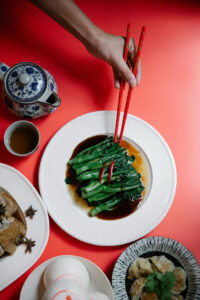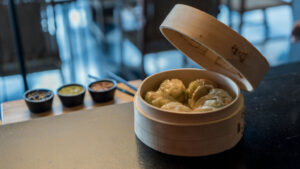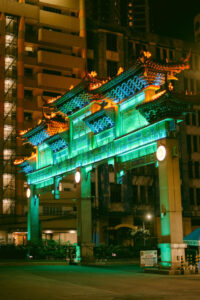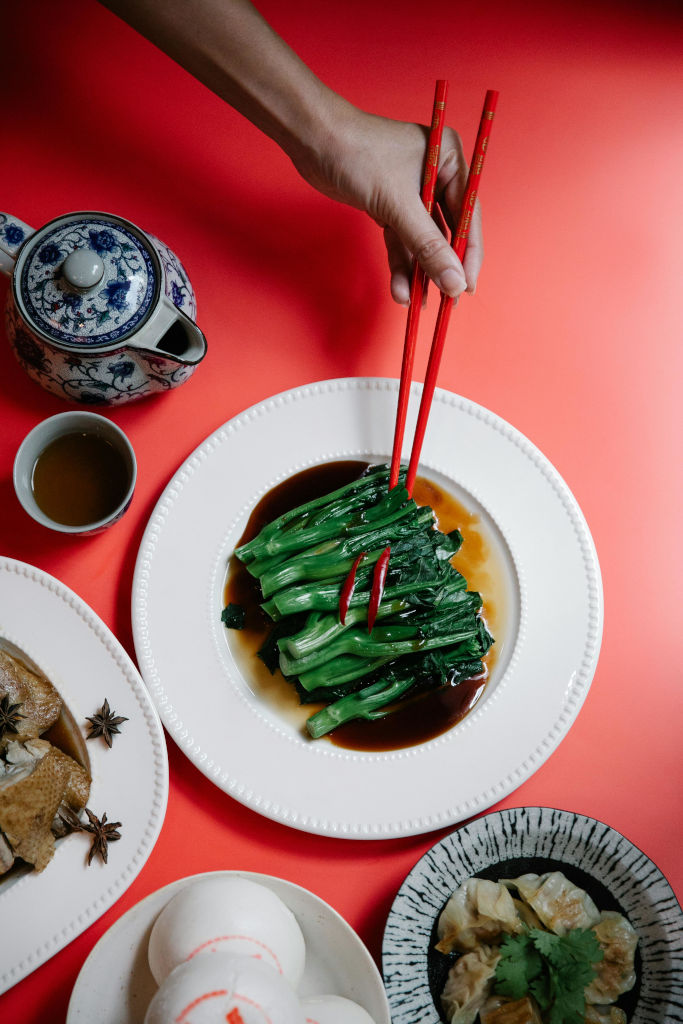The scent of roasted duck and fresh-baked hopia greeted me long before I reached Ongpin Street. It was a humid morning in Binondo — the kind that makes the air shimmer — and the streets were already alive with clattering woks, tricycle horns, and vendors calling out in a mix of Filipino, English, and Hokkien. This wasn’t just another day of eating; this was a journey through time. My Binondo food trip felt like a love letter to the city’s oldest neighborhood, where every dish tells a story of migration, memory, and shared heritage.
Morning: A Warm Welcome in Chinatown
 My first stop on the Binondo food trip was Café Mezzanine, perched above the busy Ongpin stretch. The smell of garlic and soy sauce floated up from the kitchen as I ordered a bowl of kiampong (fried rice with pork and peanuts) and a side of siomai. From my window seat, I watched the street below — red lanterns swaying over gold jewelry shops and herbal stores filled with dried roots and ginseng. Every inch of Binondo felt alive, pulsing with a rhythm that’s both ancient and modern.
My first stop on the Binondo food trip was Café Mezzanine, perched above the busy Ongpin stretch. The smell of garlic and soy sauce floated up from the kitchen as I ordered a bowl of kiampong (fried rice with pork and peanuts) and a side of siomai. From my window seat, I watched the street below — red lanterns swaying over gold jewelry shops and herbal stores filled with dried roots and ginseng. Every inch of Binondo felt alive, pulsing with a rhythm that’s both ancient and modern.
Next, I ducked into Eng Bee Tin, home of the famous ube hopia. Purple pastries lined up like tiny treasures in their glass cases. I bought a few to go — one for now, two “for later” (which, of course, didn’t make it past lunchtime). As I bit into one, the flaky crust gave way to a sweet, velvety filling that tasted like nostalgia. It’s easy to see why generations of Manileños swear by it — it’s not just dessert, it’s tradition wrapped in pastry.
Midday: Streets, Sizzles, and Stories
 By noon, the sun had turned the streets golden, and the smell of fried noodles drifted from every corner. I followed the crowd to Wai Ying Fastfood, a local institution known for its no-frills charm and unbeatable dim sum. Inside, the tables were crowded with families, students, and workers on lunch break. I ordered hakaw (shrimp dumplings), pork siopao, and a steaming bowl of wanton noodle soup. The broth was rich, the dumplings tender, and the conversation around me as warm as the food. Binondo, I realized, is one of those rare places where eating alone never feels lonely — the hum of life keeps you company.
By noon, the sun had turned the streets golden, and the smell of fried noodles drifted from every corner. I followed the crowd to Wai Ying Fastfood, a local institution known for its no-frills charm and unbeatable dim sum. Inside, the tables were crowded with families, students, and workers on lunch break. I ordered hakaw (shrimp dumplings), pork siopao, and a steaming bowl of wanton noodle soup. The broth was rich, the dumplings tender, and the conversation around me as warm as the food. Binondo, I realized, is one of those rare places where eating alone never feels lonely — the hum of life keeps you company.
After lunch, I wandered toward Escolta Street, the old financial district. It’s quieter now, its colonial-era buildings softened by age and sunlight, but the stories remain. I stopped at The Den Coffee & Contemporary Culture, a café nestled inside a restored building that once housed 1920s offices. Over iced coffee, I watched young artists sketch the view outside, bridging past and present in every line. Just a few streets away, a vendor handed me a fresh lumpia — soft, delicate, packed with sautéed vegetables and crushed peanuts. It was a reminder that some of the best discoveries on a Binondo food trip come from the simplest stalls.
Afternoon: Bakeries, Dumplings, and Heritage
 No Binondo food trip is complete without a visit to Ho-land Bakery. The smell hits you the moment you walk in — butter, sugar, and red bean paste mingling in the air. I picked up tikoy (sticky rice cake) and moon cakes, their intricate designs almost too pretty to eat. Almost. Across the street, a man in an apron stirred a wok full of maki mi (thick noodle soup with tender pork), while customers lined up, bowls in hand, waiting patiently for their turn. It’s been this way for decades, recipes passed from one generation to the next.
No Binondo food trip is complete without a visit to Ho-land Bakery. The smell hits you the moment you walk in — butter, sugar, and red bean paste mingling in the air. I picked up tikoy (sticky rice cake) and moon cakes, their intricate designs almost too pretty to eat. Almost. Across the street, a man in an apron stirred a wok full of maki mi (thick noodle soup with tender pork), while customers lined up, bowls in hand, waiting patiently for their turn. It’s been this way for decades, recipes passed from one generation to the next.
At Sincerity Café and Restaurant, one of Binondo’s legends, I sat down to a plate of their famous fried chicken — crisp, aromatic, and unlike anything else in Manila. It’s seasoned with a secret blend that tastes faintly of five-spice and comfort. Paired with fried rice and sweet banana ketchup, it was pure joy. Around me, multigenerational families gathered over heaping plates of chami and kikiam, laughter rising with the steam from the dishes. It was the kind of meal that defines a Binondo food trip — hearty, nostalgic, and proudly Filipino-Chinese.
Evening: Lanterns, Lights, and Last Bites
 As dusk fell, Binondo transformed. The red lanterns glowed brighter, reflecting on puddles from an afternoon drizzle. I followed the lights to Ying Ying Tea House, where locals squeezed into tables for late-night dim sum and congee. I ordered pork dumplings and a cup of jasmine tea, the aroma cutting gently through the cool night air. Outside, vendors grilled kwek-kwek (orange-coated quail eggs) beside glowing signboards, and the laughter of children echoed down the narrow streets.
As dusk fell, Binondo transformed. The red lanterns glowed brighter, reflecting on puddles from an afternoon drizzle. I followed the lights to Ying Ying Tea House, where locals squeezed into tables for late-night dim sum and congee. I ordered pork dumplings and a cup of jasmine tea, the aroma cutting gently through the cool night air. Outside, vendors grilled kwek-kwek (orange-coated quail eggs) beside glowing signboards, and the laughter of children echoed down the narrow streets.
I ended my day with a walk along Escolta, where vintage neon signs flickered to life, painting the walls in red and gold. A group of teenagers took selfies beside an old building; an elderly couple shared a box of hopia nearby. It struck me how food — like the city itself — connects generations. Each bite, each shared meal, is a bridge between old Manila and new.
Reflections: A City That Tastes Like Home
Walking through Binondo is like walking through a living recipe — every street, every kitchen, every smiling vendor adds a flavor of its own. It’s chaotic, noisy, crowded, and completely irresistible. As I took my last bite of hopia before heading home, I realized that Manila’s Chinatown isn’t just the heart of the city — it’s the heart of its memory.
This Binondo food trip reminded me that food is more than flavor. It’s connection — to history, to culture, and to one another. Whether you’re a first-time visitor or a lifelong local, Binondo’s charm lies in its ability to make you feel both hungry and home at once. The best meals here don’t come with a menu; they come with a story — passed down, served warm, and best enjoyed with good company.
For more local adventures around the capital, check out 33 Best Things to Do in Manila – Unforgettable Experiences in the Heart of the Philippines, or plan your next culinary journey through Klook for guided food trips in Binondo and beyond.


